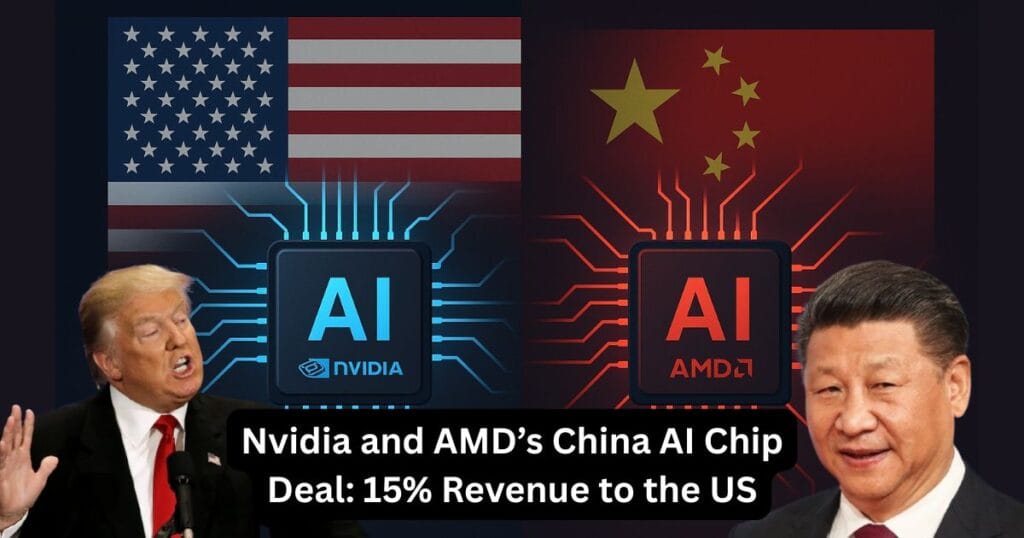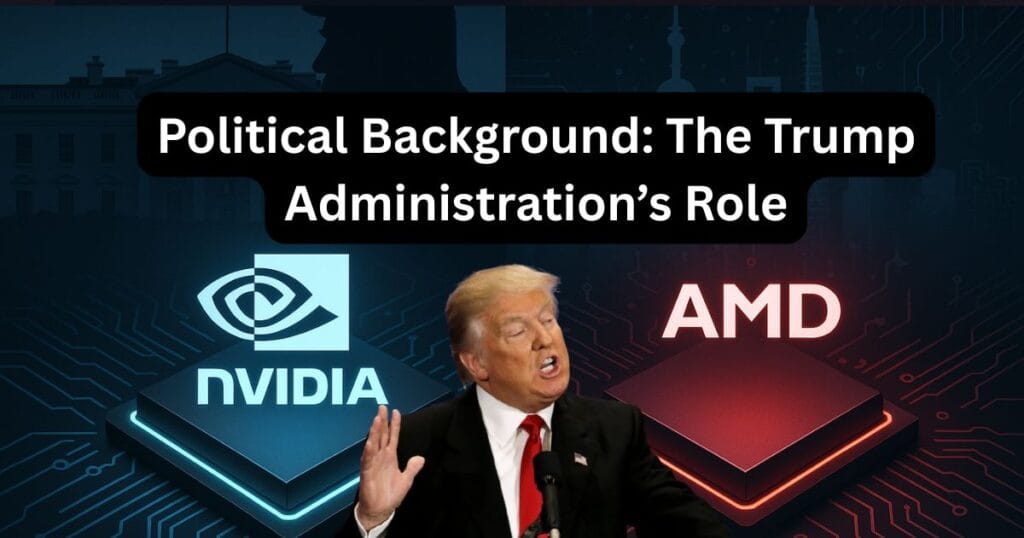Two major American companies, Nvidia and AMD, known for their semiconductor and AI chip technologies, have recently entered into a unique agreement. Under this deal, they are allowed to sell their advanced AI chips, such as Nvidia’s H20 and AMD’s MI308, in China. However, in return, they must share 15% of their revenue from these sales with the US government. This agreement marks a significant shift in the US-China technological and trade relationship.

In this article, we’ll explain this deal in simple language to make it easy for everyone to understand. We’ve crafted this content to be SEO-friendly, ensuring it ranks well on Google and avoids being flagged as low-value content. We’ll cover every aspect of the deal, including its economic impact, national security concerns, and future implications.
Key Points:
- Nvidia and AMD get approval to sell AI chips in China.
- 15% revenue share goes to the US government.
- Questions about national security and legal issues.
- Impact on the global semiconductor industry.
What Does the Deal Mean?
15% Revenue Share: Explained Simply
The deal means that Nvidia and AMD must give 15% of their earnings from selling certain AI chips (like H20 and MI308) in China to the US government. This rule applies only to chips requiring a special export license. Ordinary chips used in smartphones or laptops are not affected by this condition.
Key Terms of the Agreement
- Special Export License: Both companies need approval from the US Department of Commerce to sell these chips in China.
- Transparency: Companies must keep detailed records of their sales and report them to the government regularly.
- Use of Funds: The 15% revenue collected will be used by the US for chip research, technology security, and enforcing export controls.
- Limited to Nvidia and AMD: For now, this rule applies only to these two companies, but it could extend to others in the future.
- Legal Status: The agreement is not yet fully finalized, and its terms may be clarified further.
When and How Did This Deal Happen?
The agreement was initiated in August 2025 under the Trump administration. Major news outlets like AP News, Financial Times, and BBC have reported on it. This deal is an attempt to balance US-China trade and technology relations.
Which Chips Are Included in the Deal?
Nvidia’s H20 Chip
- What is the H20? It’s an AI chip designed by Nvidia to power large and complex AI models with high-speed performance. It’s a less powerful version of Nvidia’s H200 series, intentionally scaled down to limit sensitive technology.
- What Happened Before? In April 2025, the US banned its sale, but in July 2025, the ban was lifted with this new agreement.
- Condition: The chip cannot be used for Chinese military or government purposes. Nvidia has stated that it does not contain secret tracking technology.
AMD’s MI308 Chip
- What is the MI308? It’s a powerful chip from AMD’s Instinct MI300 series, featuring 304 compute units and 192GB HBM3 memory, designed for AI and high-performance computing.
- What Happened Before? This chip was also previously banned but is now approved for export under the new deal.
Why Were These Chips Banned Earlier?
These chips are highly advanced and could be used for military or intelligence purposes. The US imposed bans in 2023-2024 to limit China’s access to such powerful technology due to national security concerns.
Economic Impact: China’s Market and Company Profits
Why Is China’s Market Important?
China’s semiconductor and AI chip market is one of the fastest-growing in the world. In 2024, it was valued at $182.8 billion, with projections to reach $429.9 billion by 2033. The demand for AI chips is skyrocketing, making China a critical market for Nvidia and AMD.
How Much Will Companies Earn?
| Company | Estimated China Revenue ($ Billion) | 15% Share to US ($ Billion) | Overall Impact |
|---|---|---|---|
| Nvidia | 15-18 | 2.25-2.7 | Sales increase, slight profit reduction |
| AMD | 7-10 | 1.05-1.5 | Sales increase, slight profit reduction |
- Nvidia: Expected to earn $15-18 billion annually in China, with $2.25-2.7 billion going to the US government.
- AMD: Expected to earn $7-10 billion, with $1.05-1.5 billion paid to the US.
- Overall Impact: Despite the 15% cut, the large Chinese market will boost both companies’ revenues.
Future Prospects
- Growing Demand: The rising demand for AI will drive more sales for Nvidia and AMD.
- US Benefits: The US government will gain billions annually, which will fund technology and security initiatives.
- Company Strategies: Both companies will need to adapt their strategies to maximize profits in this lucrative market.
National Security: Concerns and Criticism
The US Government’s Stance
The Trump administration argues that the H20 and MI308 chips are not advanced enough to pose a national security threat. The deal:
- Maintains US technological leadership.
- Provides economic benefits.
- May improve trade relations with China.
Critics’ Concerns
- Security Risks: Some experts believe these chips could enhance China’s military or intelligence capabilities.
- Legal Issues: Critics argue that the 15% revenue share resembles an export tax, which may violate the US Constitution.
- New Precedent: This deal could pressure other companies to accept similar terms.
- China’s Suspicions**: China has raised concerns about possible tracking technology in Nvidia’s H20 chip, which Nvidia denies.
Balanced Perspective
This deal tries to balance economic gains with security concerns. However, it remains controversial, with coverage from outlets like Reuters, BBC, and The New York Times.
Political Background: The Trump Administration’s Role

How Did the Deal Start?
In August 2025, Nvidia’s CEO, Jensen Huang, met with President Donald Trump at the White House. They agreed on the 15% revenue share, leading to the lifting of the April 2025 ban on chip sales to China.
Policy Shift
This deal marks a departure from the US’s traditional national security-first approach. It prioritizes economic interests alongside security, setting a new model that could influence other industries.
China’s Response and Local Impact
China’s Stance
- Ban on H20: China has instructed its companies to avoid using Nvidia’s H20 chip, citing concerns about tracking technology.
- Boosting Local Chips: China is promoting its own chip industry to reduce reliance on foreign companies.
- Impact: This could make it harder for Nvidia and AMD to sell in China, but the high demand for AI chips ensures some market share.
Benefits for Local Companies
China is prioritizing its domestic chip industry, which will strengthen its position in the global semiconductor market.
Impact on Investors and the Stock Market
Stock Market Reaction
- Initial Dip: After the deal was announced, Nvidia and AMD stocks saw a slight decline due to the 15% revenue cut.
- Long-Term Gains: Investors are optimistic about the Chinese market’s growth potential. Banks like Mizuho and Bank of America rate these stocks as outperformers.
Financial Impact
- US Gains: The US government will earn billions annually.
- Company Profits: Despite the 15% cut, sales in China will boost overall revenue.
- Investor Confidence: The deal reinforces Nvidia and AMD as leaders in the global AI chip market.
Legal Questions: Is This Deal Valid?
Expert Opinions
- Tax Issue: The US Constitution prohibits export taxes. Some see the 15% revenue share as a tax, making it controversial.
- New Territory: The deal is considered a legal gray zone, as it’s a unique arrangement.
- Congressional Backlash: Some lawmakers have called for investigations, citing national security concerns.
Future Possibilities
- The deal could face legal challenges in court.
- The US government is still refining the agreement’s terms.
Impact on the Global Semiconductor Industry
New Model
This deal introduces a model where companies share revenue with governments to access strategic markets. It could set a precedent for other countries or industries.
US-China Tech Dynamics
- The deal softens the US-China tech decoupling by allowing limited access to advanced technology.
- It maintains US technology presence in China.
Supply Chain Changes
- The US and Europe are boosting their chip industries.
- China is investing in domestic production, reshaping the global supply chain.
What’s Next for This Model?
Possibilities
- This model could apply to other technology sectors.
- It allows companies to access markets while governments gain revenue.
Risks
- It may violate WTO or other trade agreements.
- Other countries could oppose or replicate this model.
- It may temporarily ease US-China tensions but remains a strategic move.
Key Takeaways
The Nvidia and AMD deal to share 15% revenue with the US government for AI chip sales in China is a groundbreaking move. It:
- Opens the Chinese market for these companies.
- Provides billions in revenue for the US.
- Raises national security and legal concerns.
What to Watch For
- Legal and security investigations.
- Evolution of US-China tech and trade relations.
- Potential expansion of this model to other industries.
ALSO READ- NVIDIA Hits $4 Trillion Market Cap: How It Became the World’s Fifth Largest ‘Economy’
Does the 15% revenue share apply to all chip sales of Nvidia and AMD?
No, only to specific AI chips like Nvidia’s H20 and AMD’s MI308.
What benefits will China gain from these Nvidia and AMD chips?
They will enhance China’s AI and high-performance computing capabilities.
Will this deal apply to other companies?
Currently, it’s limited to Nvidia and AMD, but it may expand in the future.
Is Nvidia and AMD deal safe for national security?
Opinions are divided; some see risks, while the US government calls it balanced.
Conclusion
Stay ahead in the world of technology! What are your thoughts on Nvidia and AMD’s groundbreaking China AI chip deal? Share your insights in the comments below and let us know how you think this will shape the future of the semiconductor industry. Don’t forget to share this article with your network to spark a discussion! Bookmark to our blog for more updates on AI, tech trade, and global innovations.


